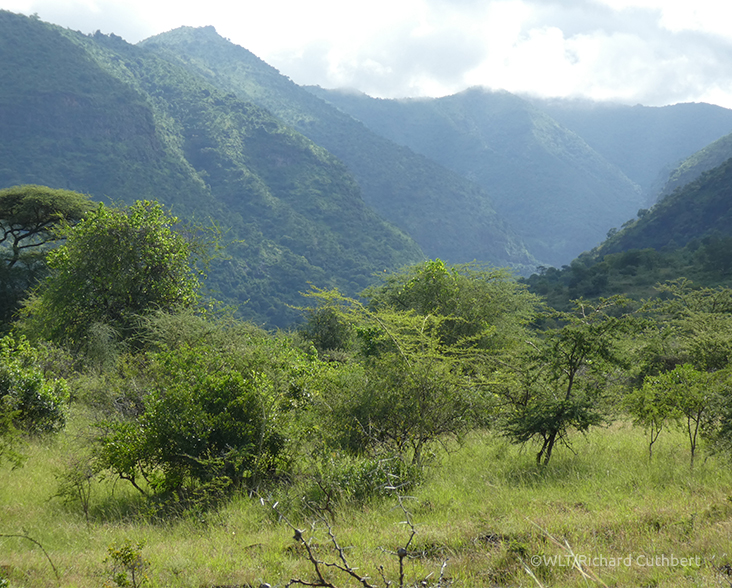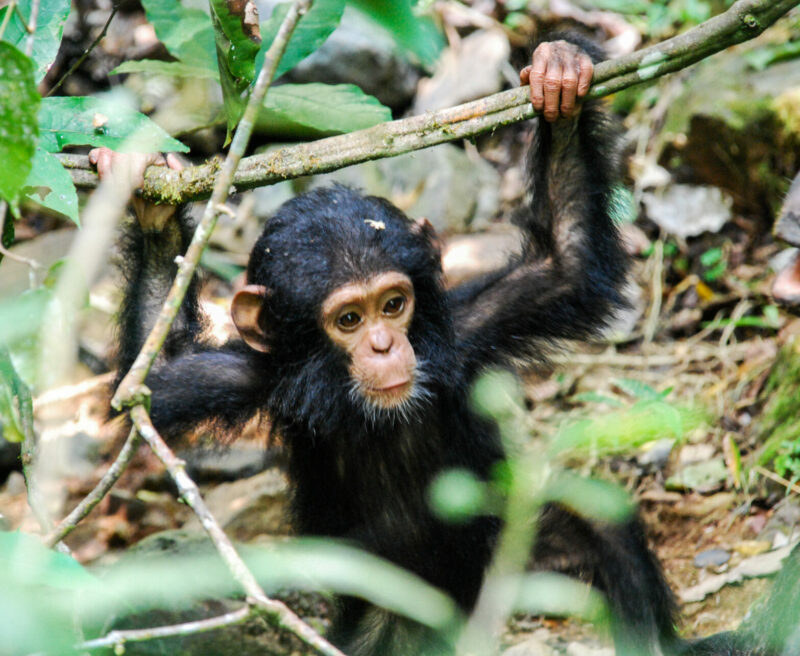Despite its relatively small size in comparison to other African countries, Uganda boasts an incredible richness of species diversity. To the west of the country lies the northern region of the Albertine Rift, a landscape that hosts more threatened and endemic vertebrates than anywhere else on the continent. Meanwhile, the tropical moist broadleaf forests of the Bwindi Impenetrable Forest are home to half of the world’s population of endangered mountain gorillas.

UGANDA
Years of support 0
HECTARES FUNDED 0 (474 acres)
HECTARES CO-FUNDED 0 (208 acres)
Trees planted 0
Unfortunately, the country is facing a severe deforestation crisis. Between 2000 to 2020, Uganda saw a net loss of 23% of its tree cover. The Ugandan economy relies heavily on small-scale agriculture, and its expanding agricultural frontier, alongside fossil fuel extraction and logging, largely drivesthe country’s forest loss.
Our partners in Uganda
Current projects in Uganda
Chimpanzee corridor
Explore the Bugoma – Budongo corridors with our Interactive Map
Murchison Falls Reserves
KARAMOJA CONSERVATION ZONES
Karamoja Conservation Zones (KTF)
Since June 2022, the Central Forest Reserves of Mount Moroto and Mount Kadam in Uganda have been the focus of KTF’s efforts in nature restoration. Rare and range-restricted species live here, many of which are not found elsewhere in Uganda, such as Roan Antelope, Leopard Orchid, and Speke’s Sand-lizard.
Unfortunately, the relatively recent development of charcoal production and firewood harvesting in Karamoja has driven the indiscriminate cutting of trees. An expanding agricultural frontier also further threatens the future of forests in this area, as does the increased occurrence of droughts, floods, landslides, and bushfires over recent decades. Additionally, extractive industries like energy and mining put pressure on the peri-urban forest habitats of Mount Moroto and Mount Kadam.
To address forest loss, WLT funds will support the protection of 10 hectares of land within and surrounding the two Central Forest Reserves border, and the planting of 76,000 trees. This will be supported by the development of training facilities for agroforestry, demonstration gardens, nurseries and other initiatives. A 25,000 hectare buffer zone of communally owned forest will be maintained around the core zone of this habitat. Here, reforestation and agroforestry efforts will take place. Through this project, Kara Tunga Foundation promote a diversity of benefits to local ethnic groups and communities, including the provision of training on agroforestry and renewable energy.


Chimpanzee Corridor CRB (EcoTrust)
This ongoing project led by EcoTrust is focused on the restoration and protection of a habitat corridor in Western Uganda between the Bugoma, Wambabya, and Bugambe forests.
Around 30 years ago, the Bugoma and Budongo forest areas were once connected via links between adjacent protected forests. Today, these once connected forests have been converted to cultivated land and plantation forests containing eucalyptus and pine wood species for timber and fuelwood. Alongside this, there are also threats from new oil extraction developments. Forest loss has led to a sever biodiversity crisis in the area, particularly for the flagship species, the chimpanzee, of which only 5,000 are thought to be left across Uganda. The forests remain in disaggregated patches and, whilst some are protected, others survive on fragmented private lands.
EcoTrust seek to secure land tenure for restoration and conservation of moist, semi-deciduous tropical rainforest habitat linkages between Bugoma, Wambabya and Bugambe forest areas. With WLT support, EcoTrust’s will safeguard an area that is home to Uganda’s remaining 5000 chimpanzees, specifically conserving 124 hectares of chimpanzee habitat. But it’s not just chimps that will benefit from this corridor, as there is an array of other primates in this region, including Blue Monkeys, Vervet Monkeys, and Olive Baboons. In addition, a remarkable 500 or more species of birds have also been recorded in the project area.
Murchison Falls Reserves
(Environmental Defenders)
(Environmental Defenders)
WLT are supporting Environmental Defenders in Uganda to create a wildlife corridor for endangered species between Murchison Falls National Park and East Madi Wildlife Sanctuary. Outside of the National Park and Wildlife Sanctuary are areas of unprotected land which are highly degraded due to deforestation which has left the remaining woodlands highly fragmented. To prevent further loss in habitat and biodiversity, Environmental Defenders strategy includes the acquisition of 210 hectares of land.
The project area constitutes one of Uganda’s most biodiverse regions, the Albertine Rift Biodiversity Hotspot. The landscape is characterised by open and dense scrub, savannah grasslands, and swamps. This has historically provided prime habitats for all four key species of African Pangolin, as well as African Elephants, Lions, Giraffes, and several Red Listed species of plants and birds, including the Endangered Grey-Crowned Crane (Balearica reguloru).
WLT funds will enable the employment of 10 local rangers to conduct regular monitoring of the project area, as well as carrying out fire prevention activities. The economic conditions of many local people are challenging, and farming livelihoods are increasingly difficult. As such, Environmental Defenders will assist people with alternative revenue streams, including offering employment in fire management activities, as well as seed collection for tree propagation.
Read how our Buy an Acre programme is protecting land in Uganda

